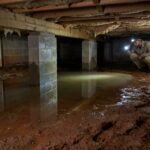Essential Guide to Foundation Repair: Preventing Costly Damage to Your Home
When it comes to home repairs, foundation issues might not be the first thing that springs to mind. You probably think of leaky roofs, peeling paint, or even that pesky toilet that won’t stop running. However, ignoring your foundation can lead to catastrophic consequences—think of it as the unsung hero holding up the whole house while silently crying for help. In this essential guide to foundation repair, we’ll delve into why your foundation matters, how to spot signs of trouble, and what steps you can take to prevent costly damage to your home.
Understanding the Importance of Your Foundation
Your home’s foundation is more than just a slab of concrete poured beneath your living room. It’s the structural backbone of your house that supports everything above, from walls and windows to fancy chandeliers and that collection of ceramic frogs you inherited from Aunt Edna. A solid foundation helps ensure that your home remains stable and safe for years to come.
Here are a few critical functions of your foundation:
1. Load Bearing: It carries the weight of the entire structure and distributes it evenly to the ground.
2. Moisture Barrier: It protects against moisture from the soil, which can lead to mold and mildew.
3. Temperature Regulation: A sturdy foundation can help insulate your home, keeping it warm in winter and cool in summer.
Without a firm foundation, your beautiful abode could quickly turn into a precarious pile of bricks and dreams. So, let’s make sure your foundation remains the steadfast pillar of support it’s meant to be!
Signs Your Foundation Needs Attention
Now that you know how important your foundation is, let’s discuss the signs that indicate it might need a little TLC. Remember, not all cracks in the wall are cause for alarm, but some definitely are. Here are several red flags to keep an eye out for:
1. Cracks in Walls: Look for vertical or horizontal cracks in your drywall. If they’re wider than a quarter-inch or seem to be expanding, it’s time to call for help.
2. Uneven Floors: If you feel like you’re on a ship rocking at sea when walking through your home, it might be more than just your balance. Sagging or sloping floors can indicate foundation movement.
3. Doors and Windows Sticking: If it feels like you’re wrestling with your doors and windows every time you try to open them, the foundation may be shifting, causing frames to warp.
4. Gaps Around Windows and Doors: Cracks or gaps appearing between the frames and the walls can be a sign of settling. Just like an awkward family reunion, you want everyone to fit comfortably together.
5. Basement Issues: If your basement is damp or has water pooling, it may indicate foundation problems and potential waterproofing issues as well.
6. External Cracks: Look outside for cracks in brickwork or masonry. If these cracks are more than just hairline fractures and seem to be getting worse, they’re worth investigating.
If you notice any of these warning signs, don’t brush them aside like that pile of laundry you promised yourself you’d get to. It’s time to take action!
Preventing Foundation Problems Before They Start
An ounce of prevention is worth a pound of cure, especially when it comes to your foundation. Here are some proactive measures you can take to protect your home:
1. Maintain Your Gutters: Clogged gutters can lead to water overflow, which can pool around your foundation and cause erosion. Regularly cleaning your gutters and downspouts will help direct water away from your home.
2. Install Proper Drainage: Ensure that your yard slopes away from your home to promote proper drainage. If necessary, consider installing a French drain system to manage water flow more effectively.
3. Water Your Yard Wisely: During dry spells, water your garden and lawn, but be cautious not to overdo it. Consistent moisture levels are vital—too much water can lead to soil expansion, and too little can cause it to shrink.
4. Check for Trees and Shrubs: Be mindful of where you’re planting trees or large shrubs. Roots can invade your foundation, leading to cracks and instability. It’s best to maintain a safe distance (about 10-15 feet away) from your foundation.
5. Inspect Your Foundation Regularly: Schedule a yearly inspection of your foundation to catch early signs of trouble. It’s easier to deal with a small crack than waiting until it resembles the Grand Canyon.
Foundation Repair: What to Expect
If your foundation does end up needing repair, don’t panic—it’s a common concern, and there are various methods to address the problem. Here’s a brief overview of common foundation repair techniques:
1. Piering: This method involves driving piers deep into the soil to stabilize and lift the foundation. It’s like giving your house a sturdy set of stilts to stand tall and proud.
2. Slabjacking: For concrete slabs that have sunk, slabjacking involves injecting a specialized mixture beneath the slab to lift it back into position. Think of it as a supportive chiropractor for your home’s foundation.
3. Wall Anchors: If your foundation walls are bowing due to pressure from the surrounding soil, wall anchors can help pull them back to safety. This technique applies tension to the wall to straighten it out.
4. Waterproofing: If moisture is a concern, consider applying a waterproofing solution to your foundation. This can help keep water at bay and prevent future issues.
5. Landscaping Solutions: Sometimes, the answer lies in the landscape. Grading, drainage systems, and retaining walls can aid in managing water flow and protecting your foundation.
Choosing the Right Professional
When it comes to something as crucial as your foundation, choosing the right contractor is vital. Research and take your time in finding a reputable professional. Here are a few tips to guide you in your search:
1. Verify Credentials: Make sure the contractor is licensed and insured. You wouldn’t want just anyone playing doctor with your house—always verify their qualifications.
2. Read Reviews: Check online reviews and testimonials. You want to choose a company with a proven history of success, not one with a trail of unhappy customers behind them.
3. Ask for References: Don’t hesitate to ask for references from past clients. A good contractor should be proud to show off their work.
4. Get Multiple Estimates: Always get a few quotes before making a decision. This allows you to compare services and prices—not to mention, it gives you an excuse to channel your inner detective.
5. Warranty and Aftercare: Ask about warranties on work performed. A quality contractor will stand by their work, giving you peace of mind.
Living With a Healthy Foundation
Once you’ve tackled any necessary repairs, the key to keeping your foundation healthy is regular maintenance. Simple practices, such as monitoring your property for signs of moisture, checking drainage systems, and maintaining landscaping, can make a world of difference in preventing future issues.
In conclusion, your foundation is the unsung hero of your home. Keeping an eye on its health and addressing problems before they escalate will save you headaches (and money) down the line. Just remember, when it comes to home maintenance, an ounce of prevention is truly worth a pound of cure. Stay vigilant, stay informed, and your foundation will continue to support you and your dreams for many years to come. Now go forth and conquer those foundation worries—your house will thank you!


